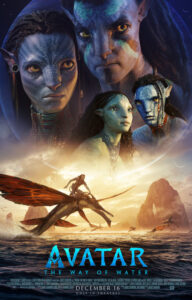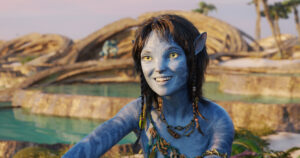Film Review: “Avatar: The Way of Water” Drowns in Incoherence
Written by: Christopher Llewellyn Reed | December 14th, 2022

Avatar: The Way of Water (James Cameron, 2022) 1 out of 4 stars.
Since (and including) his debut solo feature in 1984, The Terminator, multi-hyphenate filmmaker James Cameron has crafted a number of movies that I admire and enjoy, among them one of my favorite sequels of all time, the 1986 Aliens (his 1991 Terminator 2: Judgment Day is also quite fine). Cameron has always pushed the technological envelope, and nowhere was this more immediately evident than with his 2009 Avatar, which saw him create a brand-new planet, Pandora, out of imagination and pixels. Sure, the script was derivative, but the production design was brilliant. Now, with Avatar: The Way of Water, he returns to the director’s chair for the first time in 13 years. Much to my disappointment, it’s a mess.
Perhaps most surprisingly is the visual incoherence. A proponent not only of 3D (this new film follows its predecessor in that regard) but also of HFR (high frame rates), Cameron is convinced that anything above the traditional 24 frames per second is superior in image quality, at least for action scenes. And while he is not wrong that the original choice—back when the industry codified frame rates to synchronize picture and sound in 1927—of 24 was somewhat arbitrary, more does not always mean better. In the case of HFR as it currently exists, those extra frames lead to overly smooth pictures that feel distinctly uncinematic.

Still, tastes change, and HFR has become fairly common in the world of televised sports and video games, so viewers accustomed to such experiences may not find the technology as unpleasant as I do. But not content to simply foist HFR on the audience for an entire movie (like Peter Jackson did with his 2012 The Hobbit: An Unexpected Journey), Cameron decided to alternate between regular 24 and much higher frame rates, often cutting between them, shot to shot. The result can be dizzying, and not in a thrilling way (as opposed to what Robert Zemeckis pulled off in his 2015 The Walk – hardly a great film, but one where the technology worked to benefit the experience). And for some reason Cameron also left in weird sequences with quasi-slo-mo strobing. I am at a loss to explain them.
That horror show aside, there is the script. Where the first movie was a riff on natives-vs-colonizers in the Hollywood practice of revisionist Westerns (think the 1990 Dances with Wolves), Cameron and company at least deserve respect for now branching out into new narrative territory. Of a sort, anyway, as what follows is a family-drama-cum-coming-of-age-tale that traffics in certain well-worn tropes, as well. There is also no consistency in the linguistic universe here: sometimes English is spoken as a universal language (making it hard to grasp who understands what), and sometimes we catch snippets of the subtitled Na’vi tongue. Given the overall disarray, I suppose it doesn’t matter.

The gang is all back, even those who died last time. There is Jake (Sam Worthingon, 9 Bullets) and his wife and partner Neytiri (Zoe Saldaña, The Adam Project), but also Grace (Sigourney Weaver, Call Jane) and Quaritch (Stephen Lang, Old Man), who by all rights should be nowhere near this story except in flashback. I’m being coy, because Weaver actually mostly plays a new character, a teenager named Kiri, who bears a direct connection to the deceased Grace. What Quaritch is doing here is best left unspoiled for everyone reading this to discover on their own.
Despite the victory of Pandora’s indigenous Na’vi over their would-be human overlords at the end of Avatar, that peace is but temporary, though enough time for Jake and Neytiri to start a family and raise the two eldest into adolescence. But the people of Earth return, and this time they really mean to stay. For reasons that make little ethical sense, Jake decides that the best thing for him to is relocate Neytiri and his children to a distant ocean community (hence the title’s “water”), thereby eventually bringing all his problems to those new folks and the ones they love. Nice work, bud.

Eventually, the conflict escalates, and many innocent souls die, including massive whale-like sentient beings called “Tulkun.” I’m not sure what benefits we reap by watching, in close-up (and 3D!) the butchering of such creatures, but it sure does raise the stakes (and nausea) for what is to come. Cameron is clearly trying to send important messages about wildlife conservation and environmental protection, and that’s all for the good, but it’s wrapped in trite conversations and simplistic setup.
By the time the climactic battles (in many stages) ensue, we are well over 2 hours in (the movie clocks at over 3). Benumbed, we watch and endure the CGI carnage and alternating-frame-rate chaos, only to realize that this is but one of many planned (some already completed) episodes in this extraterrestrial saga. I may just have to sit out the rest.

As a topper, it’s hard to watch either Avatar or Avatar: The Way of Water and not be constantly reminded that the premise is a clueless dive into cultural appropriation (much as was Dances with Wolves), where a white savior dons local customs and becomes better than the indigenous population at their own tricks. At least this time Jake gets a brutal reminder that he is an outsider, but ultimately, he still prevails. Just as I am sure this movie will, my review notwithstanding.

